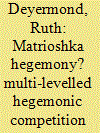| Srl | Item |
| 1 |
ID:
097899


|
|
|
| 2 |
ID:
086449


|
|
|
|
|
| Publication |
2009.
|
| Summary/Abstract |
A multi-levelled hegemonic encounter has developed in Central Asia, in which a global hegemon, the USA; a regional hegemon, the Russian Federation; an aspirant sub-regional hegemon, Uzbekistan; and an emergent regional and global hegemon, China, co-exist within the framework of Central Asian security politics. Where these hegemons' interests do not conflict this can be characterised as a matrioshka model of hegemony: the different level hegemons can accommodate one another peacefully and where their interests coincide they can form alliances. The model of multi-levelled hegemony developed here highlights the simultaneous presence of competition and cooperation. This article explores the way in which the various bilateral hegemonic relations in the region also indicate that actual and emergent hegemonic states at different levels can cooperate as hegemons in order to challenge, or to respond to challenge, by hegemonic states at other levels. This helps to clarify the question of whether the increasingly competitive interaction between these states is likely to lead to conflict.
|
|
|
|
|
|
|
|
|
|
|
|
|
|
|
|
| 3 |
ID:
143214


|
|
|
|
|
| Summary/Abstract |
The author analyzes different aspects of the “soft power” phenomenon—ideological, humanitarian and cultural—that the main geopolitical players use in post-Soviet Central Asia. He compares the “soft power” policy of the United States and the Russian Federation and their key parameters: its ideologies and values; the tools and institutions through which this policy is implemented; and the target social and other groups that, under the impact of “soft power,” become its convinced supporters and promote it in their countries.
|
|
|
|
|
|
|
|
|
|
|
|
|
|
|
|